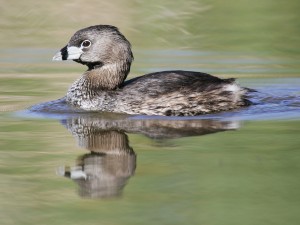Pond: A Gift That Will Keep On Giving
 The Bermuda Audobon Society is encouraging Bermudians to give a gift to both future generations of Bermudians as well as our feathered inhabitants this Christmas — a restored Seymour’s Pond.
The Bermuda Audobon Society is encouraging Bermudians to give a gift to both future generations of Bermudians as well as our feathered inhabitants this Christmas — a restored Seymour’s Pond.
In the environmental society’s Winter newsletter, executive secretary Karen Border says the Audobon Society is attempting to raise $75,000 to rehabilitate the very first nature reserve it established in 1963 — an important habitat for native birds and migratory species passing through the island.
“This beautiful reserve is located at the junction of Middle Road and South Road in Southampton and is highly visible for passing motor traffic,” said Ms Border. “Backed by a densely wooded hillside and flanked by Government-protected farmland, the slightly brackish pond provides a rich feeding ground for many species of migratory waterfowl including ducks, herons, egrets, sandpipers and kingfishers. Moorhens, coots and pied-billed grebes (pictured) have all been known to breed here.
“Sadly, over the decades, Seymour Pond’s effectiveness as a nature reserve has been compromised by a number of factors. The time has come for a major restoration project to restore the pond to its former healthy state and ensure that it continues to provide a prime wetland habitat for local and visiting waterfowl, as well as a beautiful and soothing view for the thousands of motorists who pass it each day on their way to and from work.”
Ms Border said Seymour’s Pond was established by means of a public fund-raising campign in 1963 and a further strip of land on the roadside was gifted to the Audobon Society by the Masters Estate in 1990, bringing its total size to 2.84 acres.
“Why does the pond need restoring?” she asked. “Encroachment of invasive Brazil pepper bushes around the edge of the pond and the in-growth of grasses clogging the open water have reduced the pond’s size by nearly half, making it less effective for waterfowl.
 “The pond has become increasingly contaminated by chemicals and pollution, both from road runoff that drains into it and from pesticides and herbicides used on the adjacent farmland. This contamination has been extensively documented and monitored by Dr. Jamie Bacon and her research team who are studying deformities in Bermuda’s toad population. Seymour’s Pond is one of the worst effected of the ponds in the study.
“The pond has become increasingly contaminated by chemicals and pollution, both from road runoff that drains into it and from pesticides and herbicides used on the adjacent farmland. This contamination has been extensively documented and monitored by Dr. Jamie Bacon and her research team who are studying deformities in Bermuda’s toad population. Seymour’s Pond is one of the worst effected of the ponds in the study.
“The gradual but accelerating rise in sea level associated with global warming has already drowned part of the former farmland on the pond edge, aggravating the chemical pollution problems and forcing a redesign of the boundary between fields and pond.”
Ms Border said the Society’s restoration plan aims to address the problems with the pond and enhance the wetland and woodland areas of the reserve to a higher standard of management for conservation purposes.
She said Planning permission has been granted to:
- Reinstate a part of the pond filled-in by garbage dumping in the 1930s, leaving a small islet near
the north-east end as a safe nesting site for waterfowl. - Remove the encroaching Brazil pepper and sheathed paspalum grass that are reducing the open
water area. - Excavated material will be used to re-contour the pond edge, providing a barrier between the pond
and the farmland which will prevent run-off of chemicals into the wetland.
“We must raise $75,000 to make this dream a reality,” said Ms Border. “This is Bermuda Audubon Society’s first independent capital project since the campaign to purchase Stokes Point Nature Reserve in 1980. Please give as generously as you can.”
To make an online credit card donation go to www.bermudatix.bm and click on on Bermuda Audubon
Society. Or send a cheque made payable to the Bermuda Audobon Society to: Bermuda Audubon Society, P.O. Box HM 1328, Hamilton HM FX.
Read More About
Category: All, Environment

